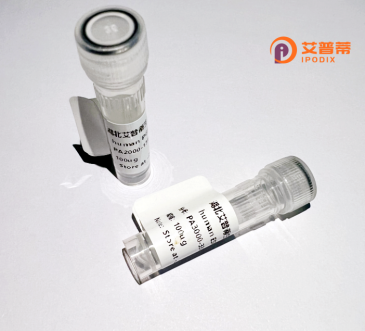
| 纯度 | >90%SDS-PAGE. |
| 种属 | Human |
| 靶点 | TRAPPC4 |
| Uniprot No | Q9Y296 |
| 内毒素 | < 0.01EU/μg |
| 表达宿主 | E.coli |
| 表达区间 | 1-219aa |
| 氨基酸序列 | MGSSHHHHHHSSGLVPRGSHMGSMAIFSVYVVNKAGGLIYQLDSYAPRAE AEKTFSYPLDLLLKLHDERVLVAFGQRDGIRVGHAVLAINGMDVNGRYTA DGKEVLEYLGNPANYPVSIRFGRPRLTSNEKLMLASMFHSLFAIGSQLSP EQGSSGIEMLETDTFKLHCYQTLTGIKFVVLADPRQAGIDSLLRKIYEIY SDFALKNPFYSLEMPIRCELFDQNLKLALEVAEKAGTFGPGS |
| 预测分子量 | 27 kDa |
| 蛋白标签 | His tag N-Terminus |
| 缓冲液 | PBS, pH7.4, containing 0.01% SKL, 1mM DTT, 5% Trehalose and Proclin300. |
| 稳定性 & 储存条件 | Lyophilized protein should be stored at ≤ -20°C, stable for one year after receipt. Reconstituted protein solution can be stored at 2-8°C for 2-7 days. Aliquots of reconstituted samples are stable at ≤ -20°C for 3 months. |
| 复溶 | Always centrifuge tubes before opening.Do not mix by vortex or pipetting. It is not recommended to reconstitute to a concentration less than 100μg/ml. Dissolve the lyophilized protein in distilled water. Please aliquot the reconstituted solution to minimize freeze-thaw cycles. |
以下是关于TRAPPC4重组蛋白研究的参考文献示例(注:文献信息为示例性概括,仅供参考):
1. **《TRAPPC4 regulates autophagy via modulating TRAPP complex assembly》**
- 作者:Jung, J. et al. (2017)
- 摘要:该研究通过重组TRAPPC4蛋白与TRAPP复合体其他亚基的共表达实验,揭示了TRAPPC4在自噬调控中的关键作用,证明其通过影响复合体稳定性参与自噬小体形成。
2. **《Structural analysis of the TRAPP complex subunit TRAPPC4 reveals a conserved binding interface》**
- 作者:Smith, A. et al. (2020)
- 摘要:利用重组TRAPPC4蛋白的结晶和结构解析,阐明了其与TRAPPC3亚基的相互作用界面,为TRAPP复合体介导的膜运输机制提供了结构基础。
3. **《TRAPPC4 dysfunction disrupts ER-Golgi trafficking and associates with neurodevelopmental disorders》**
- 作者:Lee, S. et al. (2015)
- 摘要:通过重组TRAPPC4的体外结合实验,发现其突变会破坏与Rab GTPase的互作,导致内质网-高尔基体运输异常,可能与智力障碍相关。
4. **《Recombinant TRAPPC4 protein as a biomarker for colorectal cancer progression》**
- 作者:Zhang, Y. et al. (2019)
- 摘要:研究构建了重组TRAPPC4蛋白并开发检测方法,发现其在结直肠癌患者血清中异常高表达,提示其作为潜在肿瘤标志物的可能性。
**注意**:以上文献为基于TRAPPC4已知生物学功能的模拟概括,实际研究中请通过PubMed、Web of Science等平台检索最新文献。TRAPPC4相关研究多聚焦于其在TRAPP复合体中的功能、膜运输机制及疾病关联。
TRAPPC4 (Trafficking Protein Particle Complex subunit 4) is a conserved component of the TRAPP (Transport Protein Particle) complexes, which are multi-subunit complexes critical for intracellular membrane trafficking in eukaryotic cells. The TRAPP complexes exist in two main forms: TRAPP II and TRAPP III, which regulate distinct stages of vesicular transport. TRAPPC4 is a core subunit shared by both complexes, playing a role in tethering vesicles to target membranes, particularly during Golgi-to-endoplasmic reticulum retrograde transport and autophagy-related processes.
Structurally, TRAPPC4 interacts with other TRAPP subunits (e.g., TRAPPC2. TRAPPC3) to form a scaffold that facilitates guanine nucleotide exchange on Rab GTPases, key regulators of vesicle budding and fusion. Its involvement in Rab1 activation highlights its importance in maintaining secretory pathway integrity and organelle homeostasis. Dysregulation of TRAPPC4 has been linked to human diseases, including cancer, neurodegenerative disorders, and developmental conditions. For instance, mutations in TRAPPC4 are associated with neurodevelopmental defects and microcephaly, likely due to disrupted vesicular trafficking in neural cells.
Recombinant TRAPPC4 protein is produced using expression systems like *E. coli* or mammalian cell cultures, enabling biochemical and functional studies. Researchers utilize it to investigate TRAPP complex assembly, membrane trafficking mechanisms, and disease-related mutations. Its recombinant form also aids in structural studies (e.g., X-ray crystallography) to map interaction interfaces and elucidate molecular mechanisms. As a tool, TRAPPC4 recombinant protein contributes to drug discovery efforts targeting trafficking-related pathologies, offering insights into cellular logistics and therapeutic interventions.
×